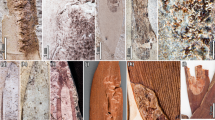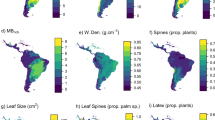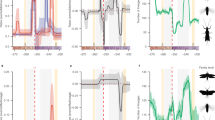Abstract
The Southern Hemisphere may have provided biodiversity refugia after the Cretaceous/Palaeogene (K/Pg) mass extinction. However, few extinction and recovery studies have been conducted in the terrestrial realm using well-dated macrofossil sites that span the latest Cretaceous (late Maastrichtian) and early Palaeocene (Danian) outside western interior North America (WINA). Here, we analyse insect-feeding damage on 3,646 fossil leaves from the latest Maastrichtian and three time slices of the Danian in Chubut, Patagonia, Argentina (palaeolatitude approximately 50° S). We test the southern refugial hypothesis and the broader hypothesis that the extinction and recovery of insect herbivores, a central component of terrestrial food webs, differed substantially from WINA at locations far south of the Chicxulub impact structure in Mexico. We find greater insect-damage diversity in Patagonia than in WINA during both the Maastrichtian and Danian, indicating a previously unknown insect richness. As in WINA, the total diversity of Patagonian insect damage decreased from the Cretaceous to the Palaeocene, but recovery to pre-extinction levels occurred within approximately 4 Myr compared with approximately 9 Myr in WINA. As for WINA, there is no convincing evidence for survival of any of the diverse Cretaceous leaf miners in Patagonia, indicating a severe K/Pg extinction of host-specialized insects and no refugium. However, a striking difference from WINA is that diverse, novel leaf mines are present at all Danian sites, demonstrating a considerably more rapid recovery of specialized herbivores and terrestrial food webs. Our results support the emerging idea of large-scale geographic heterogeneity in extinction and recovery from the end-Cretaceous catastrophe.
This is a preview of subscription content, access via your institution
Access options
Subscribe to this journal
Receive 12 digital issues and online access to articles
$119.00 per year
only $9.92 per issue
Buy this article
- Purchase on Springer Link
- Instant access to full article PDF
Prices may be subject to local taxes which are calculated during checkout



Similar content being viewed by others
References
McLoughlin, S., Carpenter, R. J., Jordan, G. J. & Hill, R. S. Seed ferns survived the end-Cretaceous mass extinction in Tasmania. Am. J. Bot. 95, 465–471 (2008).
Jiang, S., Braklower, T. J., Patzkowsky, M. E., Kump, L. R. & Schueth, J. D. Geographic controls on nannoplankton extinction across the Cretaceous/Palaeogene boundary. Nat. Geosci. 3, 280–285 (2010).
Barreda, V. D. et al. Cretaceous/Paleogene floral turnover in Patagonia: drop in diversity, low extinction, and a Classopollis spike. PLoS ONE 7, e52455 (2012).
Wilf, P., Cúneo, N. R., Escapa, I. H., Pol, D. & Woodburne, M. O. Splendid and seldom isolated: the paleobiogeography of Patagonia. Annu. Rev. Earth Planet. Sci. 41, 561–603 (2013).
McLoughlin, S., Carpenter, R. J. & Pott, C. Ptilophyllum muelleri (Ettingsh.) comb. nov. from the Oligocene of Australia: last of the Bennettitales? Int. J. Plant Sci. 172, 574–585 (2011).
Vajda, V., Raine, J. I. & Hollis, C. J. Indication of global deforestation at the Cretaceous-Tertiary boundary by New Zealand fern spike. Science 294, 1700–1702 (2001).
Vajda, V. & McLoughlin, S. Fungal proliferation at the Cretaceous-Tertiary boundary. Science 303, 1489 (2004).
Iglesias, A. et al. A Paleocene lowland macroflora from Patagonia reveals significantly greater richness than North American analogs. Geology 35, 947–950 (2007).
Clyde, W. C. et al. New age constraints for the Salamanca Formation and lower Río Chico Group in the western San Jorge Basin, Patagonia, Argentina: implications for Cretaceous-Paleogene extinction recovery and land mammal age correlations. Geol. Soc. Am. Bull. 126, 289–306 (2014).
Comer, E. E. et al. Sedimentary facies and depositional environments of diverse early Paleocene floras, north-central San Jose Basin, Patagonia, Argentina. Palaios 30, 553–573 (2015).
Case, J. A. & Woodburne, M. O. South American marsupials: a successful crossing of the Cretaceous-Tertiary boundary. Palaios 1, 413–416 (1986).
Apesteguía, S., Gómez, R. O. & Rougier, G. W. The youngest South American rhynchocephalian, a survivor of the K/Pg extinction. Proc. R. Soc. B. 281, 20140811 (2014).
Witts, J. D. et al. Macrofossil evidence for a rapid and severe Cretaceous–Paleogene mass extinction in Antarctica. Nat. Commun. 7, 11738 (2016).
Kennedy, E. M. Late Cretaceous and Paleocene terrestrial climates of New Zealand: leaf fossil evidence from South Island assemblages. N. Z. J. Geol. Geophys. 46, 295–306 (2003).
Pole, M. & Vajda, V. A new terrestrial Cretaceous-Paleogene site in New Zealand—turnover in macroflora confirmed by palynology. Cretac. Res. 30, 917–938 (2009).
Steinthorsdottir, M., Vajda, V. & Pole, M. Global trends of pCO2 across the Cretaceous–Paleogene boundary supported by the first Southern Hemisphere stomatal proxy-based pCO2 reconstruction. Palaeogeogr. Palaeoclimatol. Palaeoecol. http://dx.doi.org/10.1016/j.palaeo.2016.04.033 (2016).
Wilf, P., Labandeira, C. C., Johnson, K. R. & Ellis, B. Decoupled plant and insect diversity after the end-Cretaceous extinction. Science 313, 1112–1115 (2006).
Labandeira, C. C., Johnson, K. R. & Wilf, P. Impact of the terminal Cretaceous event on plant-insect associations. Proc. Natl Acad. Sci. USA 99, 2061–2066 (2002).
Currano, E. D. et al. Sharply increased insect herbivory during the Paleocene-Eocene Thermal Maximum. Proc. Natl Acad. Sci. USA 105, 1960–1964 (2008).
Donovan, M. P., Wilf, P., Labandeira, C. C., Johnson, K. R. & Peppe, D. J. Novel insect leaf-mining after the end-Cretaceous extinction and the demise of Cretaceous leaf miners, Great Plains, USA. PLoS ONE 9, e103542 (2014).
Carvalho, M. R. et al. Insect leaf-chewing damage tracks herbivore richness in modern and ancient forests. PLoS ONE 9, e94950 (2014).
Wing, S. L. et al. Late Paleocene fossils from the Cerrejón Formation, Colombia, are the earliest record of Neotropical rainforest. Proc. Natl Acad. Sci. USA 106, 18627–18632 (2009).
Wappler, T., Currano, E. D., Wilf, P., Rust, J. & Labandeira, C. C. No post-Cretaceous ecosystem depression in European forests? Rich insect-feeding damage on diverse middle Palaeocene plants, Menat, France. Proc. R. Soc. B 276, 4271–4277 (2009).
Wappler, T. & Denk, T. Herbivory in early Tertiary Arctic forests. Palaeogeogr. Palaeoclimatol. Palaeoecol. 310, 283–295 (2011).
Scasso, R. A. et al. Integrated bio- and lithofacies analysis of coarse-grained, tide-dominated deltaic environments across the Cretaceous/Paleogene boundary in Patagonia, Argentina. Cretac. Res. 36, 37–57 (2012).
Wilf, P. & Labandeira, C. C. Response of plant-insect associations to Paleocene-Eocene warming. Science 284, 2153–2156 (1999).
Labandeira, C. C., Wilf, P., Johnson, K. R. & Marsh, F. Guide to Insect (and Other) Damage Types on Compressed Plant Fossils Version 3.0. (Smithsonian Institution, 2007); http://paleobiology.si.edu/insects/index.html
Schulte, P. et al. The Chicxulub asteroid impact and mass extinction at the Cretaceous-Paleogene boundary. Science 327, 1214–1218 (2010).
Vajda, V., Ocampo, A., Ferrow, E. & Koch, C. B. Nano particles as the primary cause for long-term sunlight suppression at high southern latitudes following the Chicxulub impact—evidence from ejecta deposits in Belize and Mexico. Gondwana Res. 27, 1079–1088 (2015).
Aberhan, M. & Kiessling, W. Rebuilding biodiversity of Patagonian marine molluscs after the end-Cretaceous mass extinction. PLoS ONE 9, e102629 (2014).
Gradstein, F. M., Ogg, J. G., Schmitz, M. & Ogg, G. The Geologic Time Scale 2012 (Elsevier, 2012).
R Development Core Team R: A Language and Environment for Statistical Computing (R Foundation for Statistical Computing, 2013).
Acknowledgements
The authors thank E. Currano, K. Johnson, P. Puerta, L. Reiner and E. Ruigómez for field and laboratory assistance and T. Bralower, D. Hughes and M. Patzkowsky for discussion. This study was supported by grants to M.P.D. from the Evolving Earth Foundation, the Geological Society of America, Sigma Xi, the Paleontological Society and the P. D. Krynine Memorial Fund of Penn State Department of Geosciences; and to P.W., A.I. and N.R.C. from NSF awards DEB-0919071 and DEB-1556666.
Author information
Authors and Affiliations
Contributions
M.P.D., A.I., P.W. and C.C.L. designed the research. M.P.D., A.I., P.W. and N.R.C. did the fieldwork. M.P.D., A.I. and C.C.L. collected the DT data. N.R.C. led research on the Lefipán flora. M.P.D. performed the analyses and wrote the manuscript. All authors commented on and substantially contributed to the manuscript.
Corresponding author
Ethics declarations
Competing interests
The authors declare no competing financial interests.
Supplementary information
Supplementary information
Supplementary Methods, Supplementary Discussion, Supplementary Figures 1–10, Supplementary Tables 1 and 2 and Supplementary References (PDF 1722 kb)
Supplementary Data
Occurrences of insect damage types on Patagonian fossil floras. (XLSX 818 kb)
Rights and permissions
About this article
Cite this article
Donovan, M., Iglesias, A., Wilf, P. et al. Rapid recovery of Patagonian plant–insect associations after the end-Cretaceous extinction. Nat Ecol Evol 1, 0012 (2017). https://doi.org/10.1038/s41559-016-0012
Received:
Accepted:
Published:
DOI: https://doi.org/10.1038/s41559-016-0012
This article is cited by
-
A Maastrichtian insect assemblage from Patagonia sheds light on arthropod diversity previous to the K/Pg event
Communications Biology (2023)
-
Chicxulub impact winter sustained by fine silicate dust
Nature Geoscience (2023)
-
Landscape-level variability and insect herbivore outbreak captured within modern forests provides a framework for interpreting the fossil record
Scientific Reports (2023)
-
Oldest leaf mine trace fossil from East Asia provides insight into ancient nutritional flow in a plant–herbivore interaction
Scientific Reports (2022)
-
The Mesozoic terminated in boreal spring
Nature (2022)



